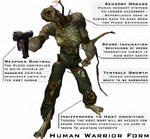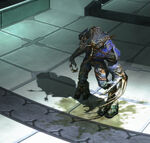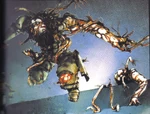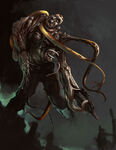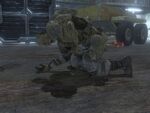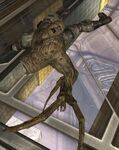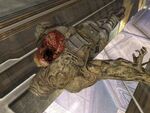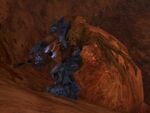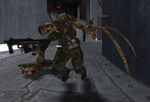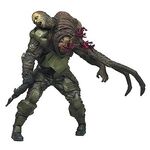| This article may not meet the grammar standards of Halo Alpha. Please repair this article so that it meets our standard. |
Knowing that monster firing a Battle Rifle at you used to be Kevin from 2nd Platoon is just creepy. That could be me.
|
A Flood Combat Form[2] is an organism deemed suitable for combat that has been infected by the Flood parasite via an Infection Form or Flood Spores, mutating the victim into a combat unit for use by the Flood. They are extremely dangerous, but can be easily defeated when alone or feral; However, when under the control of a Gravemind they can be coordinated and deadly.
Pathology
A Combat Form is not a natural organism, but rather a mutated host infected by parasitic Flood Super Cells implanted by an Infection Form. Successful creation of a Combat Form requires a host with sufficient biomass and calcium storage, and an Infection Form to infect the host. After mutation begins, the infection form attaches with one of its tentacles, which it uses to establish a neural connection that allows it to command the host's nervous system, thus rendering command of the legs and arms useless. During the infection process, the host's internal organs are liquefied, and the nutrients from them are used to develop the tentacles and other appendages.
A host becomes a Combat Form after an Infection Form enters its body. Transformation involves brutal mutations that makes the host more suitable for combat. This process is presumably very painful and terrifying, and will kill the host; though, in certain circumstances, the host is still alive. Once fully transformed, the Infection Form has total control over the host's body and changes the physical appearance of the host to better suit its own needs (although an infected host will be roughly the same size as it was before). On rare occasions, this effect may be weakened by time in stasis for the Infection Form, allowing the host to regain some control, as in the case of Private First Class Wallace Jenkins.[3] Combat Forms retain the host's previous attributes, therefore they can wield weapons, and drive and board enemy vehicles. However, Infection Forms do not require their hosts to still be alive for infection. Even dead hosts are suitable for conversion into a Combat Form; infection forms can infect recently deceased hosts and reanimate them in much the same way as they would living hosts. Although the brain tissue remains dead, the victim's biomass and calcium reserves are sufficient to warrant infection.
In the initial stage of a Flood outbreak, the Feral Stage, Combat Forms communicate using pheromones and have one instinctual behavior; to secure new hosts to strengthen the local controlling intelligence. Once a sufficient store of biomass is available the Flood enters the Coordinated Stage, and begins forming Pure Form Flood, with the Combat Forms being used either as defensive units or calcium/biomass reserves.
Infected hosts are rapidly digested while being converted, which leaves the host severely ravaged and decayed, much like a corpse that has been exhumed a few weeks after its burial.[4] Flood infection is a rapid and efficient biological process, as it can take under a minute in certain cases. A group of Flood will occasionally go after Sentinels if they are perceived to be the greatest threat in the area, although they are unable to be infected by the Flood due to their robotic and inorganic nature.
Types of Combat Forms
A specific creature is needed for the infection and creation of a Combat Form. Of the various Covenant races, only a few species meet the necessary requirements. Species known to be immune to conversion include the Mgalekgolo/Lekgolo, whose complete lack of skeletal calcium (i.e. bones) and central nervous system, colonial physiology, and insufficient biomass per individual worm make infection and neural synchronization impossible for Infection Forms, the Yanme'e, whose exoskeleton lacks the required amount of calcium which renders infection impossible, and the Huragok, which is an artificial, gas-based organism, and therefore believed to be immune. Even though the above species are immune to conversion into combat forms, they are still probably used for extra biomass.
All victims of the Flood's infection, regardless of their physiology, will undergo the reanimation process where the hosts will experience its skin decaying rapidly (if they were infected while alive), growing whip-like appendages which will serve as their primary melee weapon in close-combat situations and have their heads (which are useless to the Infection Form, as it is now in command of any and all neural activity) pushed aside. In Halo 3, the reanimation process can be witnessed; the host will twitch around in pain and eventually collapse on the ground. For a live transformation, the Infection Form will force the host's neck to be snapped, thus allowing the Infection Form to gain complete control over the host's body. Afterward, the whip appendages will force itself out of host's left arm, and the Infection Form will force itself out of the host's chest.
If available, the Combat Forms are able wield the arsenals of the UNSC and those of the Covenant. In Halo 2, all Combat Forms are also capable of driving and boarding vehicles and are able to do so in Halo 3, though the ability to drive vehicles is lost. They still retain the ability to board slow moving vehicles, however.
All Flood can escape from grenades, though the Elite Combat Form has a stronger chance of dodging a grenade lobbed at it. Also, note that on Floodgate, the Combat Forms disintegrate into Infection Forms, which is somewhat unusual.
Human Form
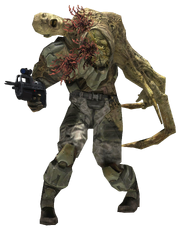
A Human Combat Form
The Human Combat Form is significantly smaller than other forms due to their original smaller size. As with other Combat Forms, it is capable of sustaining massive physical damage before being unusable to the Flood Infection Form; in fact, as long as the chest cavity and legs remain intact, it will continue to fight. Although it cannot take as much damage as the Sangheili Combat Form can, the Human Form has some advantages.
It seems to be more alert and is quicker to melee an opponent. It also presents a smaller, harder target to hit, especially the Infection Form, as it isn't protruding out of the body as much as those of Sangheili Forms. However, in Halo 3, the Human form becomes an easier target to hit; the Infection Form protrudes a lot more out of the host's chest and becomes a visibly significant target, and it seems to be significantly slower.
This can take more melee hits than its Brute version, so it is advised to avoid melee combat with them apart from the Energy Sword or Gravity Hammer as these are the only two weapons that can destroy them instantly.
There are two animations for a live transformation in Halo 3, the former being that the Marine will hold their chest where the Infection Form entered and will fall on their knees and commit forced-suicide by snapping their neck. The host will then be on the floor, and the tendrils will tear out of their arms. The second animation is the Marine is forced a few steps back and then attempt to run forward. Afterwards, the host will fall on the floor and start thrashing until the tentacles snap out.
Sangheili (Elite) Form
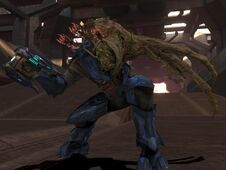
An Elite Combat form
The Sangheili Combat Form is a formidable enemy as it is very agile and resilient. It is also capable of utilizing it's host's armor abilities, such as active camouflage and energy shields, to assist them in combat. The Sangheili Combat Forms are slightly larger than the Human form and, as such, present a larger target.
In Halo 2, all of the Sangheili form encountered use one armor palette; the Sangheili minor's combat harness. In Halo 3 however, the Sangheili forms will retain its host's armor palette. The strength of each Sangheili Form depends on the ranks of its host; an infected Sangheili Major will be considerably more resilient than a Sangheili Minor.
These forms are much more evasive then their other counterparts; if attacked with a plasma grenade it may still charge, but at a distance they will evade thrown explosives.
Jiralhanae (Brute) Form
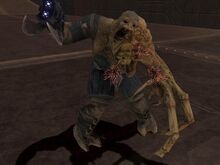
Brute Combat Form
The Jiralhanae Combat Form is a formidable enemy and is more aggressive in combat than other Combat Forms and will charge towards an opponent recklessly; this behavior is most likely a result of the Jiralhanae's savage nature and preference for close combat.
The Jiralhanae Form is the most powerful in offensive capabilities because of their aggressive nature. However, they are the least durable out of all of the Combat Forms. It is bulkier and slower than other Combat Forms and as Jiralhanae cannot be infected until their Power Armor is destroyed, the Jiralhanae Form cannot make use of their host's armor abilities.
This is the easiest Combat Form to kill; on Legendary a melee attack kills it instantly, while it takes some time to accomplish on the Human and Elite Combat Forms. Jiralhanae forms stuck with grenades may charge at their opponents to kill them with the blast.
Infinity Spartan Combat Form
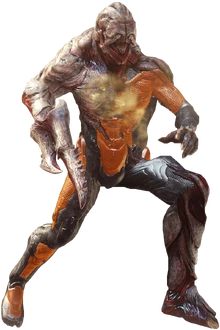
Spartan Combat Form
The Spartan Forms are a Flood assimilation of a Spartan-IV supersoldier used in the virtual training simulations aboard the UNSC Infinity; the purpose likely being to train S-IV personnel to combat the Flood parasite in the event of a resurgence. The unusual aspect of these forms is their lack of an Infection Form controlling them, however this could be a result of spore infection, or even more simply the Infection Form is just left out of the simulation entirely. It is likely that the Spartan Form is a specialized unique form created within the simulation specifically to train Spartan-IV personnel against the absolute deadliest of Flood infantry. The body shape of these forms remain the same, with the exception of the arm, chest and head having been deformed, giving the infected a menacing and more grotesque appearance. The MJOLNIR armor has been completely purged, and as a result they have lost their shields, though their Flood physiology compensates for this. Although their simulation prevents them from utilizing firearms it is likely within their physical abilities. However, they can utilize armor abilities making them extremely versatile opponents. It is uncertain whether or not actual SPARTAN-IVs control the forms within the simulation or if they are controlled by artificial intelligence. Unlike the tendrils of standard Combat Forms, the Spartan Form's unique claw is usually powerful enough to kill a fully-shielded SPARTAN-IV in a single strike. The simulations were probably designed so that the simulation Flood were overpowered compared to actual Flood. This concept is similar to how baseball batters put weights on their bats during training.
SPARTAN-II Variant Combat Form
The Spartan II combat form is a SPARTAN-II exposed to the Flood infection that has never been formally encountered. A unique characteristic is the positioning of the infection form inside the cranial cavity of the host. This causes the host's head to grow substantially, splitting their helmet apart to accommodate for the Infection form's size. The rest of the body is almost completely intact.
This combat form is only encountered in the Infection gametype in Halo 2: Anniversary.
Unggoy and Kig-yar Combat Forms
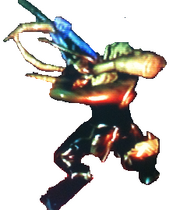
A Jackal Combat Form.
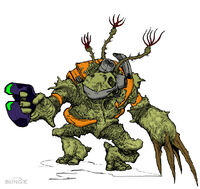
Bungie concept art of an infected Unggoy.
These forms do not appear in the first trilogy and are instead introduced in Halo Wars.[notes 1] Rarely seen in actual combat situations, infected Unggoy and Kig-yar are more commonly converted into Carrier Forms or processed for their biomass. These "building blocks" can be used to add to a Gravemind's superstructure or be molded into Flood Pure Forms.
Unggoy and Kig-yar Combat Forms have only been witnessed in the first recorded contact between the Covenant and the Flood. It is possible that these weaker forms were quickly ruled out by the Flood and determined to be a less efficient use of biomass after only just a few battles. They are weaker, slower, and easier to kill than their Sangheili Combat Form brethren.
Forerunner Combat Form
A Forerunner Combat Form seen in a Terminal video
Though never encountered, countless Forerunner Combat Forms existed during the Forerunner-Flood War. One can be seen in a stasis tank aboard Installation 04 in the Halo: Anniversary Terminal videos, though it is seen from behind and is in shadow so it's full appearance is never seen. Another Forerunner Combat Form is seen as a simulation of the Didact infected by the Flood. Once again, the image is not clearly vivible as the hologram is blurry, though one claw appendage is visible as well as other amorphous growths on the body.
Countermeasures
Combat Forms can take extensive and sizable amounts of damage before being neutralized. Arms, legs and even heads can be dismembered before they are incapacitated. The weak areas of a Combat Form are its sensory appendages that normally develop on the upper chest. This is where the Infection Form has nestled, and the body is incapacitated if this area is destroyed by a projectile weapon.
In all three Halo games, a Combat Form may fall only to stand up again and keep fighting. This can only happen if it still has a usable limb and appendage. In Halo 2 and Halo 3, if the body is not destroyed, Combat Forms can be revived if another Infection Form crawls into it.
Human weapons are generally more effective against the Flood, as Covenant plasma weaponry is designed to debilitate targets by causing burning pain and structural damage to bodies, and the Flood cannot feel pain or be crippled.[5] However, In Halo 3, plasma-based weaponry and melee attacks, formerly weak against the Combat Forms in the previous two games, are now highly effective. Piercing weapons such as the Sniper Rifle and the Beam Rifle have little effect on Combat Forms. At a distance, explosive ordnance such as grenades and ranged weapons such as the Battle rifle or the Covenant Carbine can perform well against Combat Forms. Do note that Plasma and Spike grenades should be used with caution, as the Combat Form will sometimes ignore all other targets and charge players using such weapons at high speed. The Needler can be devastating, as the supercombine explosion will prevent it coming back to life in Halo: Combat Evolved, and will shatter it in Halo 2 and 3. In addition, the Needler's explosions will destroy an entire horde of charging Flood Combat Forms, similar to grenades and rocket launchers. For ranged weapons, it is recommended for players to focus their fire at the sensory appendages that are visible on Combat Forms as successfully firing at one will immediately bring down a Combat Form. Dismemberment with ranged weapons is also recommended to prevent Combat Forms from firing their held weapons. At close combat, it is recommended that individuals acquire close-quarters weapons such as the Shotgun, Energy Sword and Gravity Hammer as they perform exceptionally well against Combat Forms. Burning Combat Forms with sufficient amounts of heat is one of the most effective methods in any situation, as is the destruction of the torso. Automatic weapons are also effective.
Also pain causes a weakening of the Flood Infection Form and allows the host, if still alive, to regain control albeit briefly. This is shown with PFC Wallace A. Jenkins.
Trivia
General
- In Halo: Combat Evolved Combat Forms will not disintegrate from successive melee hits when they are dead like in Halo 2 and Halo 3.
- Flood Combat Forms seem to take on physiological and biological changes throughout the Halo trilogy; these changes from game to game could be due to the Gravemind's influence in attempting to create a better Flood soldier or they could simply be graphical updates.
- Human flood forms always seem to have a screaming human face when infected, which is, in all likelihood, the last face the host made.
- Some Elite flood combat forms still have shields.
- PFC Wallace A. Jenkins was able to prevent himself from being controlled by the flood even though he was infected.
- Terminal 4 of Halo: Combat Evolved Anniversary shows what appears to be a Forerunner Combat Form in a specimen tank. Another of these, also in a tank, along with several Infection Forms can be seen being studied by the Librarian in Terminal 2 of Halo 4.
- Both times, the specimen is viewed from behind and the specimen is partially concealed in shadow and cannot be seen fully.
Halo: Combat Evolved
- In all of the Halo games, Flood Combat Forms always hold the Shotgun with one hand, and fire it without pumping another round into the chamber. They somehow manage to make the shotgun pump itself. A possible explanation for this is that the Flood has extended an appendage into/onto the Shotgun which allows it to use the Shotgun's pump as a body part, or the pump action just wasn't programmed into Halo: Combat Evolved.
- Combat Forms in Halo: Combat Evolved don't tend to dodge grenades.
- Combat forms will run towards the player when armed. Both Human Combat forms and Sangheili Combat Forms will berserk when they have their arm that holds a gun shot off and will rush the player. Combat Forms that are unarmed will rush the player by default.
- In the campaign level 343 Guilty Spark, if you stand on a light Bridge, the Flood combat forms will leap onto the bridge and get stuck. They will only be able to move by jumping at you.
- If you shoot both arms off a Combat Form in Halo: Combat Evolved it will not be able to attack you and will simply follow you around. Players have dubbed this instance as creating a "Flood Buddy".
- This is the only game in which an Infection Form cannot revive a dead Combat Form; instead they may just get back up.
- In Halo: Combat Evolved, all human combat forms are bare foot. The reason for this remains unknown and is strange because human combat forms have shoes in Halo 2 and Halo 3. It might have undergone constant mutation but this is unlikely.
- During The Maw, a medium sized group of Sangheili combat forms can be found at the back of the armory, what is most interesting about this group is the fact they have active camo engaged, despite the model showing no parts of armor at all.
Halo 2
- Halo 2 is the only game where the Flood are able to drive vehicles.[6]
- When using the Grunt Birthday Party skull against the Flood in Halo 2, the effect of the skull will cause the plasma grenade explosion to occur when you shoot the Combat Form in the chest, where the Infection Form is.
- Reflecting their enhanced intelligence, human combat forms still wear the armor they had on when they first transformed making it significantly harder to shoot the infection form in their chest. Elite forms can now also have shields which recharge over time. Once the shield is taken, though, they are very easy to incapacitate.
- If you shoot both arms off a Combat Form, the Combat Form will walk slowly then explode, releasing an Infection Form.
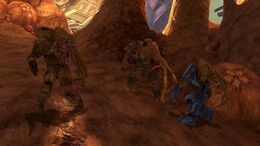
All Halo 3 Combat forms on an infected High Charity
Halo 3
- The Combat Form can pick up any weapon should it be near them when they "resurrect". They will also pick up two handed weapons such as the Plasma Cannon and Flamethrower if close by. Like other weapons, they will wield it with only one hand. Depending on the circumstances, they are unable to use these weapons, effectively making them harmless apart from their whip arm if it hasn't been removed yet.
- The Combat Form's performance in CQC is inferior compared to Halo 2. They can't operate or jack vehicles, and don't have the ability to sprint or berserk.
- Probably to prevent the player from getting a big combat advantage from Jiralhanae combat forms during the brief time they are allies in The Covenant, or perhaps to prevent enemy Flood combat forms from overwhelming the player, weapons that would normally be picked up when a Jiralhanae combat form "resurrects" are deleted by the game's code, rendering them unusable.
- An infected Jiralhanae Chieftain will turn into the generic Jiralhanae Combat Form character model, which is used for all Jiralhanae that become infected, regardless of rank or armor type. This is a pattern shown throughout the games; Combat Forms are all portrayed with a singular generic character model, depending on the species that is infected.
- Regardless of gender, an infected Human Flood becomes a male Combat Form. There are no variations between an infected male or female Marine, because there is only one character model for a Human Combat Form in the game.
- Combat forms are capable of speech in an echoing voice. They usually speak for the Gravemind or quote their host.
- A glitch made it possible for the player to become infected on Floodgate, when they die.
- If a Combat Form's two arms are destroyed, the host will disintegrate and an Infection Form is released.
- You can give them any weapon you want them to have (during the part when you and the flood team up).
- Unlike the first and second Halo games, the red appendages can be shot to kill them instantly, where they didn't have that for the first two Halo games (they did, but you couldn't do a "headshot" on them.)
- Regardless of the Elite armor types, if an Elite with an Assault helm is infected, the helm is somehow removed from the host.
- With Halo 3, infected Elite ranks will have the armor that their host used. For example, if a Sangheili Ultra was infected, the Combat Form will host white armor instead of blue. However, if the body is destroyed, the armor pieces will turn into that of a Sangheili Minor.
- Oddly enough, when a Sangheili Combat Form is killed and an Infection Form crawls inside it, when shooting at the Combat Form (when it's being revived), they make use of the shields immediately.
- The "Flood Buddy Glitch" can be used in Halo 3 if one were to encounter a Combat Form with no weapon. Shoot off the host's head and then the tentacle arm. It will follow you but deal no damage. This is pretty much useless since the Covenant and Flood are never found in the same level except in the Citadel when the Flood are your allies, and on Floodgate, when you meet up with a squad of elites for a brief time.
- A strategy to kill flood is to duel-wield an SMG and a Plasma Rifle.[citation needed]
- If an ODST is infected, they will become a generic Human Combat Form.
- When a dead being is infected, it will jerk around as if it were still alive (although, no sound) this could be the host's nervous system.
Halo Wars
- Jackals that get infected, whether upgraded or not, would be equipped with a Carbine that, strangely enough, shoot Beam rifle shots. This remains true to ODSTs that get infected and will turn into normal infected Marines equipped with Assault rifles.
- Grunt Squads that get infected would be split into two different forms. One would be either an Elite Combat Form or Brute Combat form (Depending on leader) and the rest of the squad will become Grunt combat Forms.
- Elite Combat Forms are the only host infected Combat forms in Halo Wars that do not equip a weapon.
- The Flood units are significantly weaker than they are from the other Halo games but are efficient in taking out Infantry.
Halo 4
- Though technically not in Halo 4, the Combat Form appears in the new Flood game type, as the infected Spartan IVs.
- The only weapons they have is the Flood Claw, located on their right arm.
- They are able to use Armor Abilities such as Thruster Pack, Active Camo and Promethean Vision.
Gallery
Notes
- ↑ While no canon source ever denied it was possible for Grunts or Jackals to be converted, it was thought that they were unsuitable for conversion due to their small size and an assumed lack of sufficient calcium stores. Instead of using Grunts and Jackals as Combat Forms, the Flood typically used them as a type of 'nucleus' that a Carrier Form would grow around. The two species had originally been intended by Bungie to become Combat Forms, but limitations in resources and staff at the time of the formative years of the franchise led to the introduction into the fiction of the Unggoy's and Kig-yar's unsuitable status as Combat Forms. They would also serve as building blocks for a Gravemind. It wasn't until the release of Halo Wars that they were formally implemented in-game.
Sources
- ↑ Halo: Spartan Assault, Random Pre-Game Quote.
- ↑ Halo: The Flood, page 225: "The first of these combat forms he'd seen had once been Elites."
- ↑ Halo: The Flood, page ??
- ↑ Halo: The Flood, page 220
- ↑ Halo: Evolutions - Essential Tales of the Halo Universe - The Mona Lisa
- ↑ Halo 2, Quarantine Zone
| |||||||||||||||||

